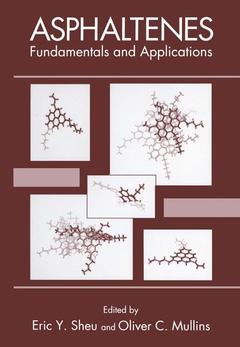Asphaltenes, Softcover reprint of the original 1st ed. 1995 Fundamentals and Applications
Langue : Anglais
Coordonnateurs : Subirana Maite, Sheu Eric Y.

Asphaltenes have traditionally been viewed as being extremely complex, thus very hard to characterize. In addition, certain fundamental properties of asphaltenes have pre viously been inaccessible to study by traditional macroscopic methods, further limiting understanding of asphaltenes. These limitations inhibited development of descriptions regarding the microscopic structure and solution dynamics of asphaltenes. However, a variety ofmore recent studies have implied that asphaltenes share many chemical properties with the smaller, more tractable components of crude oils. Recent measurements have indicated that asphaltene molecular weights are not as !arge as previously thought, perhaps in the range of 600 to I 000 amu. In addition, new experimental methods applied to asphaltene chemical structures have been quite revealing, yielding a broad understanding. Conse quently, the ability to relate chemical structure with physical and chemical properties can be developed and extended to the understanding of important commercial properties of asphal tenes. This book treats significant new developments in the fundamentals and applications of asphaltenes. In the first section ofthe book, new experimental methods are described that characterize asphaltene structures from the molecular to colloidallength scale. The colloidal properties are understandable in terms of asphaltene chemical structures, especially with regard to the heteroatom impact on bonding. However, quantitative measurements of the of asphaltene self-association still need to be determined. In the second section of enthalpy this book, the fundamental understanding of asphaltenes is related riirectly to asphaltene utilization.
Colloidal Properties of Asphaltenes in Organic Solvents (E.Y. Sheu, D.A. Storm). Sulfur and Nitrogen Molecular Structures in Asphaltenes and Related Materials Quantified by XANES Spectroscopy (O.C. Mullins). Solubility and Phase Behavior of Asphaltenes in Hydrocarbon Solvents (R. Cimino et al.). The Colloidal Nature of Asphaltenes as a Unifying View for the Analyses of Solubility and Interfacial Phenomena (S. Acevedo et al.). The Effects of Asphaltenes on the Chemical and Physical Characteristics of Asphalt (M.S. Lin et al.). Asphalt Emulsion for Environmental Coating and Encapsulation (H. Lian, T.F. Yen). Potential of Ultrasonic Generators for Use in Oil Wells and Heavy Crude Oil/Bitumen Transportation Facilities (M.R. Islam). A New Method of Asphaltic Crude Disposal and Utilization (M.R. Islam). Index.
Date de parution : 04-2013
Ouvrage de 246 p.
17.8x25.4 cm
Disponible chez l'éditeur (délai d'approvisionnement : 15 jours).
Prix indicatif 105,49 €
Ajouter au panier
© 2024 LAVOISIER S.A.S.



